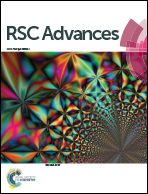Mesostructure-tunable and size-controllable hierarchical porous silica nanospheres synthesized by aldehyde-modified Stöber method†
Abstract
Mesostructure-fine-tuned and size-controlled hierarchical porous silica nanospheres were synthesized by aldehyde-modified Stöber method in the TEOS–CTAB–NH3·H2O–aldehyde system. The samples were characterized by XRD, N2 adsorption–desorption isotherms, SEM, TEM and TG analysis. The results indicate that the particle size of the micro/mesoporous silica nanospheres synthesized with acetaldehyde as a co-solvent can be controlled from 40 to 850 nm by regulating the molar ratio of acetaldehyde to water and the initial pH of the synthesis solution. When propionaldehyde or butyraldehyde was used as a co-solvent, hierarchical porous silica nanospheres with large cone-like cavities and small mesopores in the cavity wall were synthesized; the diameter of the flower-like nanospheres is less than 130 nm. The hierarchical pore structure of the flower-like silica nanospheres can be fine-tuned by controlling the polymerization of butyraldehyde by the synthesis temperature from 27 to 100 °C, both the depth and opening diameter of the cone-like cavities can be fine-tuned from 40 to 2 nm; simultaneously, the small mesopores templated by CTAB become more ordered.


 Please wait while we load your content...
Please wait while we load your content...